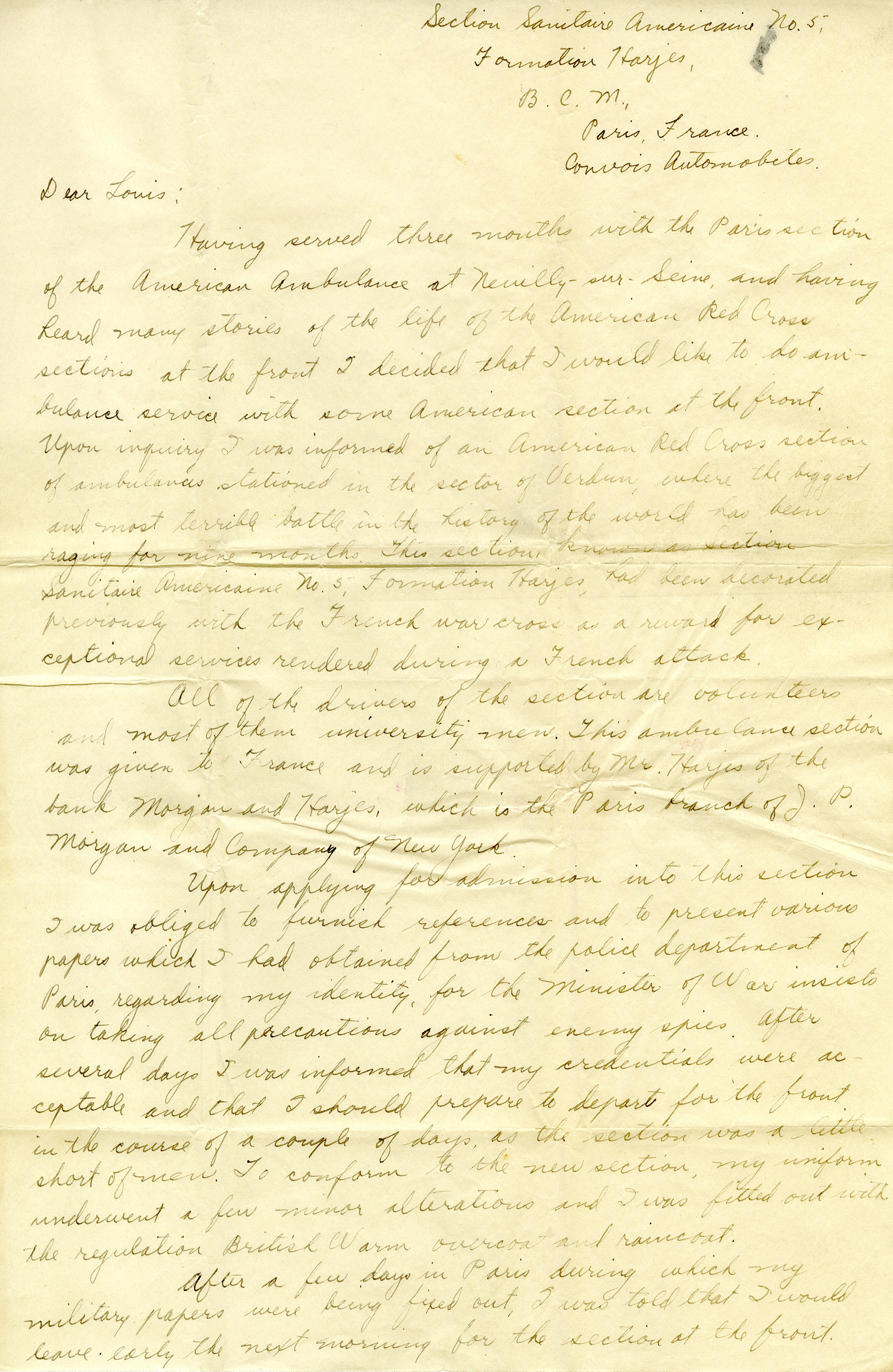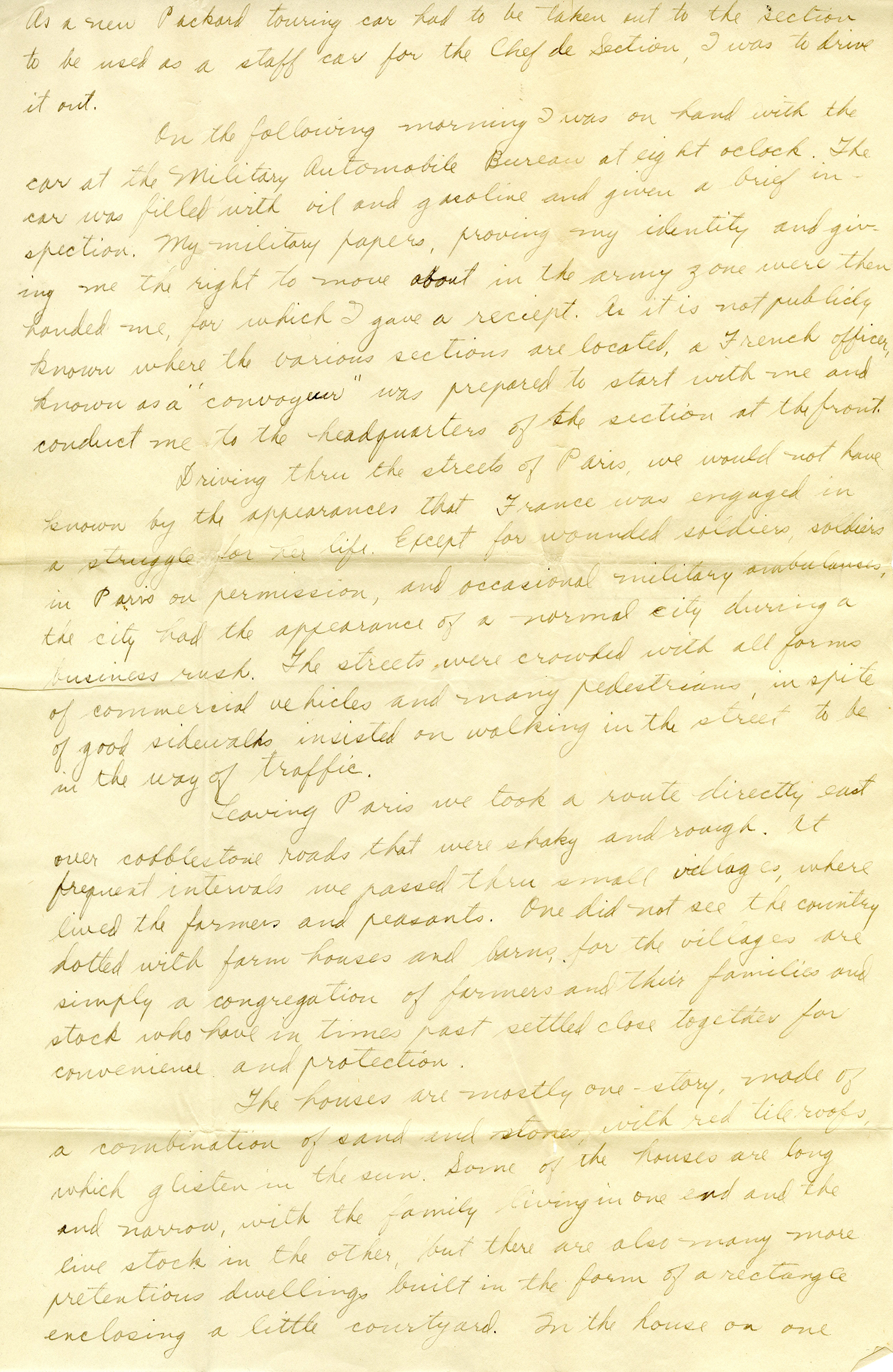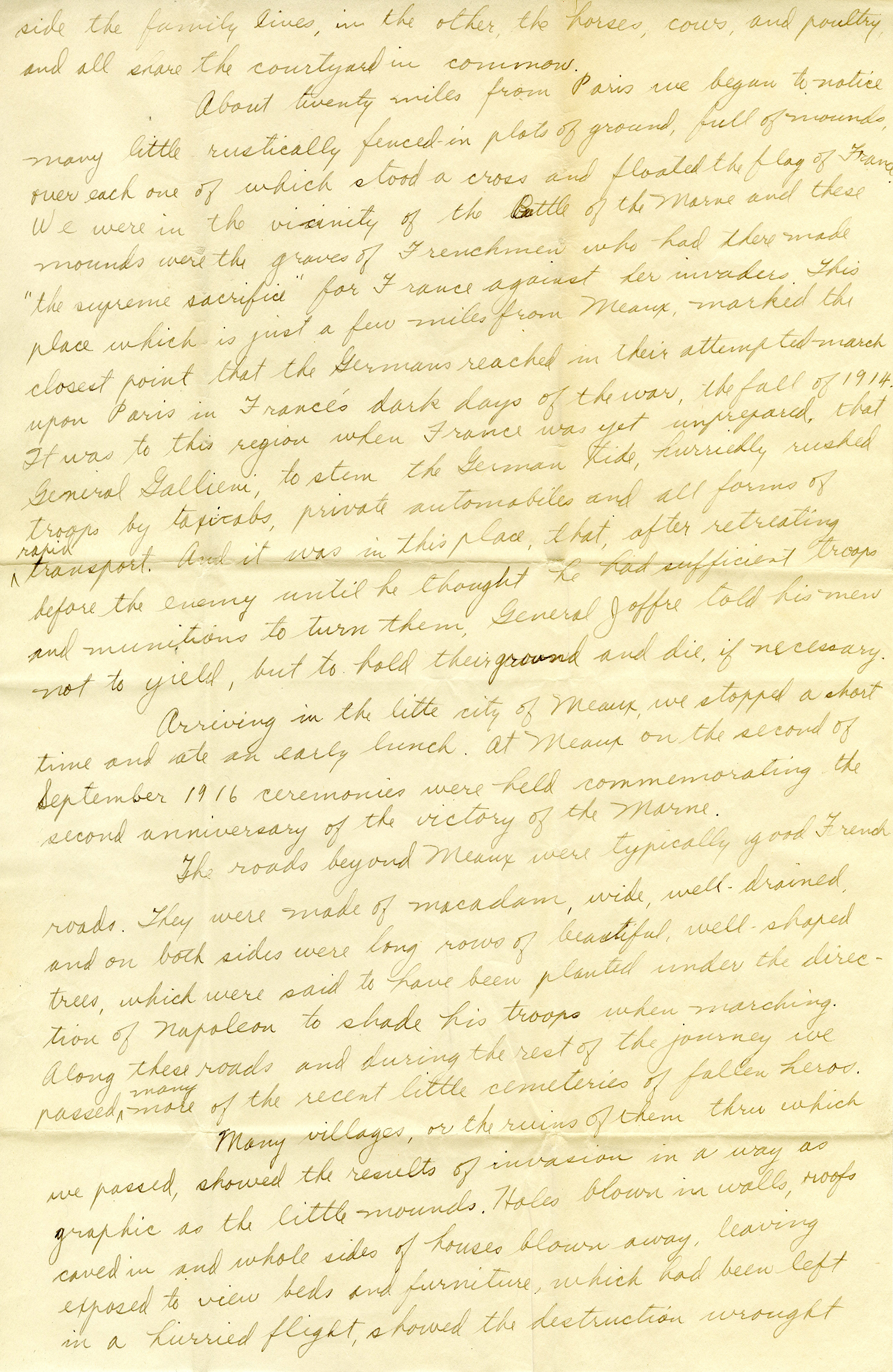Transcript
Section Sanitaire Americaine No. 5,
Formation Harjes,
B.C.M.,
Paris, France,
Convois Automobiles
Dear Louis:
Having served three months with the Paris section of the American Ambulance at Neuilly-sur-Seine, and having heard many stories of the life of the American Red Cross sections at the front I decided that I would like to do ambulance service with some American section at the front. Upon inquiry I was informed of an American Red Cross section of ambulances stationed in the sector of Verdun, where the biggest and most terrible battle in the history of the world has been raging for nine months. This section, known as Section Sanitaire Americaine No. 5, Formation Harjes has been decorated previously with the French war cross as a reward for exceptional services rendered during a French attack.
All of the drivers of the section are volunteers and most of them university men. This ambulance section was given to France and is supported by Mr. Harjes o the bank Morgan and Harjes, which is the Paris branch of J.P. Morgan and Company of New York.
Upon applying for admission into this section I was obliged to furnish references and to present various papers which I had obtained from the police department of Paris, regarding my identity, for the Minister of War insists on taking all precautions against enemy spies. After several days I was informed that my credentials were acceptable and that I should prepare to depart for the front in the course of a couple of days, as the section was a little short of men. To conform to the new section, my uniform underwent a few minor alterations and I was fitted out with the regulation British Warm overcoat and raincoat.
After a few days in Paris during which my military papers were being fixed out, I was told that I would leave early the next morning for the section at the front. As a new Packard touring car had to be taken out to the section to be used as a staff car for the Chef de Section, I was to drive it out.
On the following morning I was on hand with the car at the Military Automobile Bureau at eight oclock [sic]. The car was filled with oil and gasoline and given a brief inspection. My military papers, proving my identity and giving me the right to move about in the army zone were then handed me, for which I gave a receipt. As it is not publicly known where the various sections are located, a French officer, known as a “convoyeur” was prepared to start with me and conduct me to the headquarters of the Section at the front.
Driving thru the streets of Paris, we would not have known by the appearances that France was engaged in a struggle for her life. Except for wounded soldiers, soldiers in Paris on permission, and occasional military ambulances, the city had the appearance of a normal city during a business rush. The streets were crowded with all forms of commercial vehicles and many pedestrians, in spite of good sidewalks insisted on walking in the street to be in the way of traffic.
Leaving Paris we took a route directly east over cobblestone roads that were shaky and rough. At frequent intervals we passed thru small villages, where lived the farmers and peasants. One did not see the country dotted with farm houses and barns, for the villages are simply a congregation of farmers and their families and stock who have in times past settled close together for convenience and protection.
The houses are mostly one-story, made of a combination of sand and stones, with red tile roofs, which glisten in the sun. Some of the houses are long and narrow, with the family living in one end and the live stock [sic] in the other, but there are also many more pretentious dwellings built in the form of a rectangle enclosing a little courtyard. In the house on one side the family lives, in the other, the horses, cows, and poultry and all share the courtyard in common.
About twenty miles from Paris we began to notice many little rustically fenced-in plots of ground, full of mounds, over each one of which stood a cross and floated the flag of France. We were in the vicinity of the Battle of the Marne and these mounds were the graves of Frenchmen who had there made “the supreme sacrifice” for France against her invaders. This place which is just a few miles from Meaux, marked the closest point that the Germans reached in their attempted march upon Paris in France’s dark days of the war, the fall of 1914. It was to this region when France was yet unprepared, that General Gallieni, to stem the German tide, hurriedly rushed troops by taxicabs, private automobiles and all forms of rapid transport. And it was in this place, that, after retreating before the enemy until he thought he had sufficient troops and munitions to turn them, General Joffre told his men not to yield, but to hold their ground and die, if necessary.
Arriving in the little city of Meaux, we stopped a short time and ate an early lunch. At Meaux on the record of September 1916 ceremonies were held commemorating the second anniversary of the victory of the Marne.
The roads beyond Meaux were typically good French roads. They were made of macadam, wide-well-drained, and on both sides were long rows of beautiful, well-shaped trees, which were said to have been planted under the direction of Napoleon to shade his troops when marching. Along these roads and during the rest of the journey we passed many more of the recent little cemeteries of fallen heros [sic].
Many villages, or the ruins of them thru which we passed, showed the results of invasion in a way as graphic as the little mounds. Holes blown in walls, roofs caved in and whole sides of houses blown away, leaving exposed to view beds and furniture, which had been left in a hurried flight, showed the destruction wrought by the big guns. One village had hardly a single house standing, for all the buildings had been razed to the ground and it could be likened only to the ruins of Pompei [sic]. In some of the villages to which the civilian population had begun to return, small frame shacks and tents had been erected which were temporarily used for stores and various public purposes.
From Bar-le-Duc, where we were detained a short time to have our military papers viewed, we took a route towards Verdun. The road, always kept in good repair, was wide and it was well that it was so far big convoys of army vehicles were continually passing. Convoys of motor trucks, convoys of horse drawn wagons, officer’s cars shooting by at a terrific rate, cavalry troops, and soldiers in big motor vans going to and coming from the front; such are the things we met and one realizes more than ever that the actual fighting is only a small part of the war and that there are more men in the branches of the service than there are in the trenches.
While running along the road the French “convoyeur” pointed towards the sky ahead of us and in looking up I saw many little bird-like puffs of smoke which followed each other in pleasing curves. I was told that they were the bursting shrapnel shells show from the French guns at a German aeroplane which was taking observation of the French lines.
One hour later and we had arrived at the camp of our section and were greeted by an eager bunch of healthy Americans in drag uniforms.
Trusting that I will have time to write you more later, I am,
Yours very sincerely,
Luther.
Metadata
Title: Letter 11, Luther Nelson to Louis
Date: 1916
Collection: RG1/051, Luther Nelson Collection, 1916-1918
Repository: Archives of the American Field Service and AFS Intercultural Programs
Creator: Nelson, Luther
Publisher: Digitized by AFS staff in 2016.
Rights Statement: This item cannot be reproduced outside the guidelines of United States Fair Use (17 U.S.C., Section 107) without advance permission of the Archives of the American Field Service and AFS Intercultural Programs. In the event that this letter becomes a source for publication, a credit line indicating the Archives of the American Field Service and AFS Intercultural Programs is required.
Digital ID: 1_051_11





